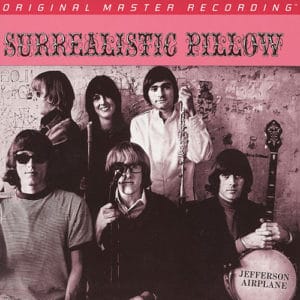Marketplace
2015 Mobile-Fidelity Sound Lab PRESSING
- RPM 45
- Audio Mono
- Catalog Number MFSL 2-456
- Release Year 2015
- Vinyl Mastering Engineer Krieg Wunderlich
- Pressing Weight 180g
- # of Disks 2
- Jacket Style Gatefold
- 100% Analog Mastering Yes
- Original Release Year 1967
- Original Label RCA Victor
- Original Catalog # LPM 3766
The Jefferson Airplane’s second LP, Surrealistic Pillow, gave notice that San Francisco in 1967 was the epicenter of the counterculture, even more so than swinging London. Established Bay Area bands such as the Grateful Dead and Quicksilver Messenger Service already existed, but Surrealistic Pillow gained AM radio play with “Somebody to Love,” which brought Jefferson Airplane and the Summer of Love into many American households.
Jefferson Airplane had already released a debut, Jefferson Airplane Takes Off, the year before. Something in the air seemed to inject more experimentation and radicalism into music, and the group took a big leap with their second record. The band solidified its new sound (slightly harder-edged but retaining folk-rock elements) when it hired vocalist Grace Slick and drummer Spencer Dryden. Surrealistic Pillow comes on tougher and more focused than the band’s debut, and plays to the instrumental strengths of guitarist Jorma Kaukonen and bassist Jack Casady.
Significant sonic differences distinguish the original mono edition from the stereo version. The latter format has a heavier layer of echo. The mono uses the effect more judiciously, and some tracks vary in other ways, such as the more pronounced bass on “Comin’ Back to Me.” Mobile Fidelity’s choice to release the album in mono on two LPs cut at 45RPM is the correct aesthetic choice since it happens to be the best way to hear this music.
More importantly, the new pressing registers a distinct improvement over the original. Guitar tones come through with better clarity, the bass features extra heft, and the vocals are more clearly separated. The tones of Dryden’s drums on the intro of “She Has Funny Cars” feel more distinct, and the slight amount of fuzz tone added to Casady’s bass registers with striking clarity. On the original, when Slick and Marty Balin harmonize, their voices are crammed together, but here, it’s much easier to hear each singer.
Similarly, the voices on the wonderful folk-rock tune “My Best Friend” feel richer and harmonically deeper on the Mobile Fidelity, and Casady’s more audible, firmer bass gives the track a stronger foundation. Kaukonen’s electric-guitar lines ring truer and the acoustic guitar playing possesses added drive. In addition, the acoustic guitars on “Today” sound more resonant and warm, the tambourine in the background is less aggressively splashy than on the earlier pressing, and Dryden’s percussion more dramatically builds on the Mobile Fidelity.
The reissue also gives more space for the rock tunes to spread out, which makes it easy to hear each of the vocalists on “3/5 of a Mile in 10 Seconds” and lets all the guitar parts bloom. Slick’s vocal on “White Rabbit” is more expressive, and Kantner’s rhythm guitar strikes have a slightly sharper echo behind them that firms up the arrangement. Balin’s vocal on “Plastic Fantastic Lover” conveys the snarl of the original, but the sibilance is tamed and, as a result, he sounds less self-righteous.
I also compared the Mobile Fidelity with the 33RPM mono pressing Sundazed released in 2003. Overall, the Sundazed sounds very good, less bright than the original and nicely balanced. However, as soon as I played “Somebody to Love” on the Mobile Fidelity and could more clearly visualize where Paul Kantner’s voice is placed in relation to Slick’s, just behind and in support, I knew it’s the version everyone should own—as well as more transparent, dynamic, full, and musical. Don’t miss it.
Surrealistic Pillow


 4.5
4.5